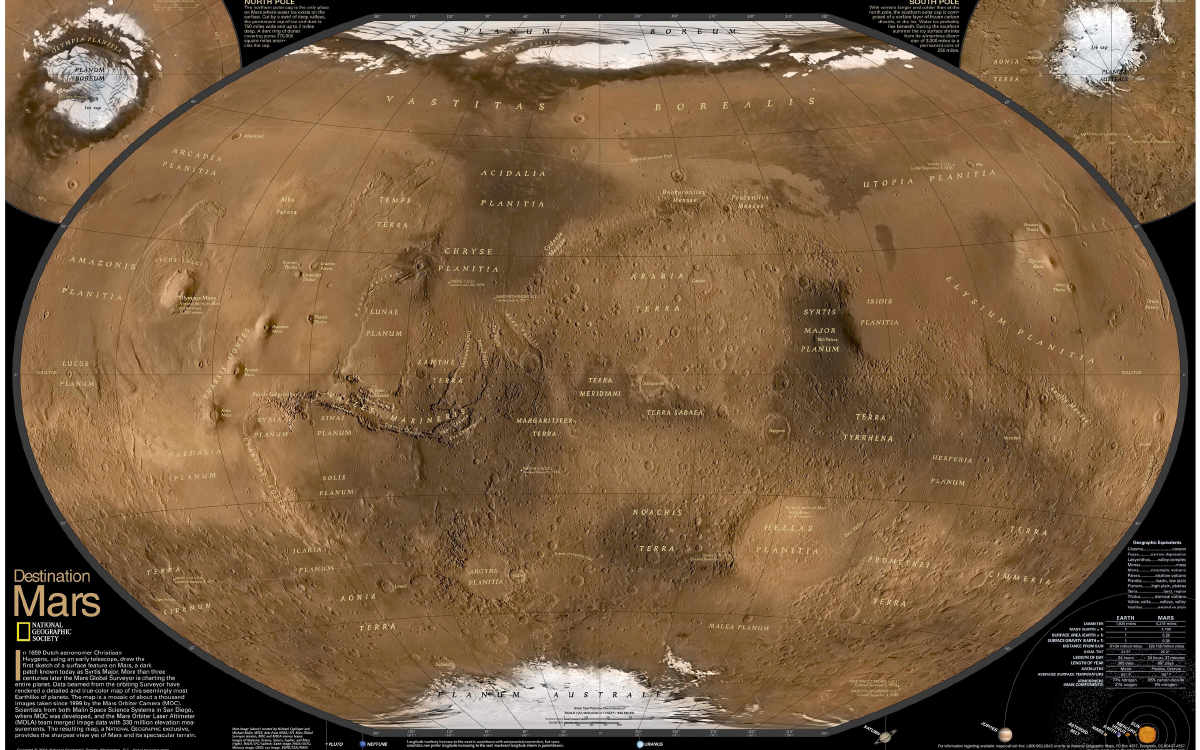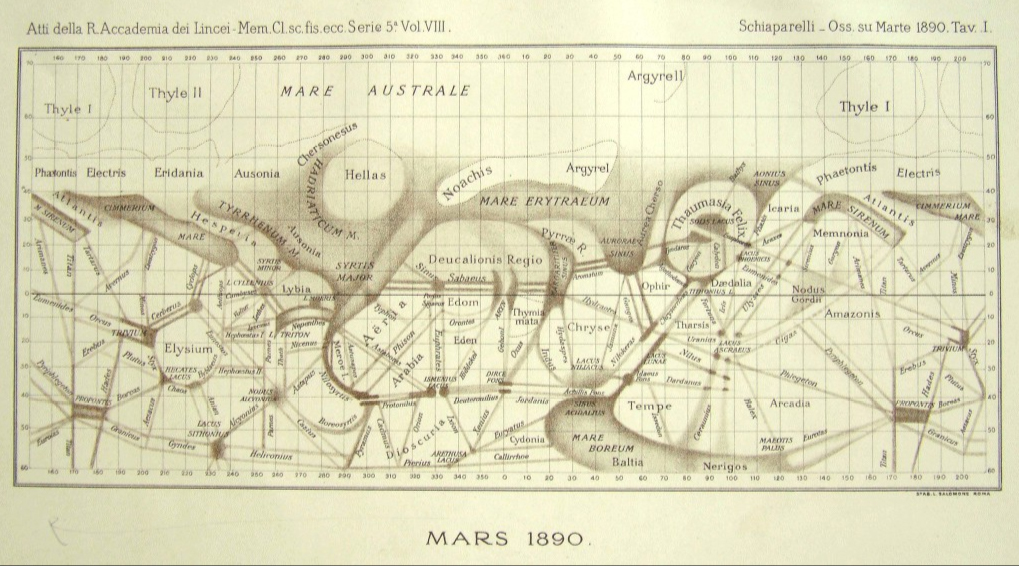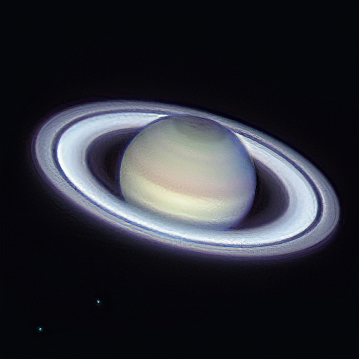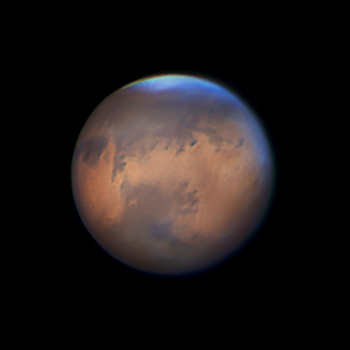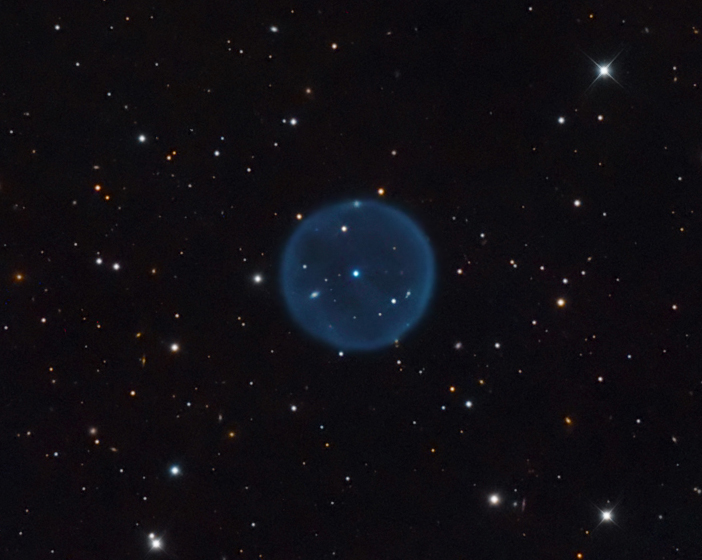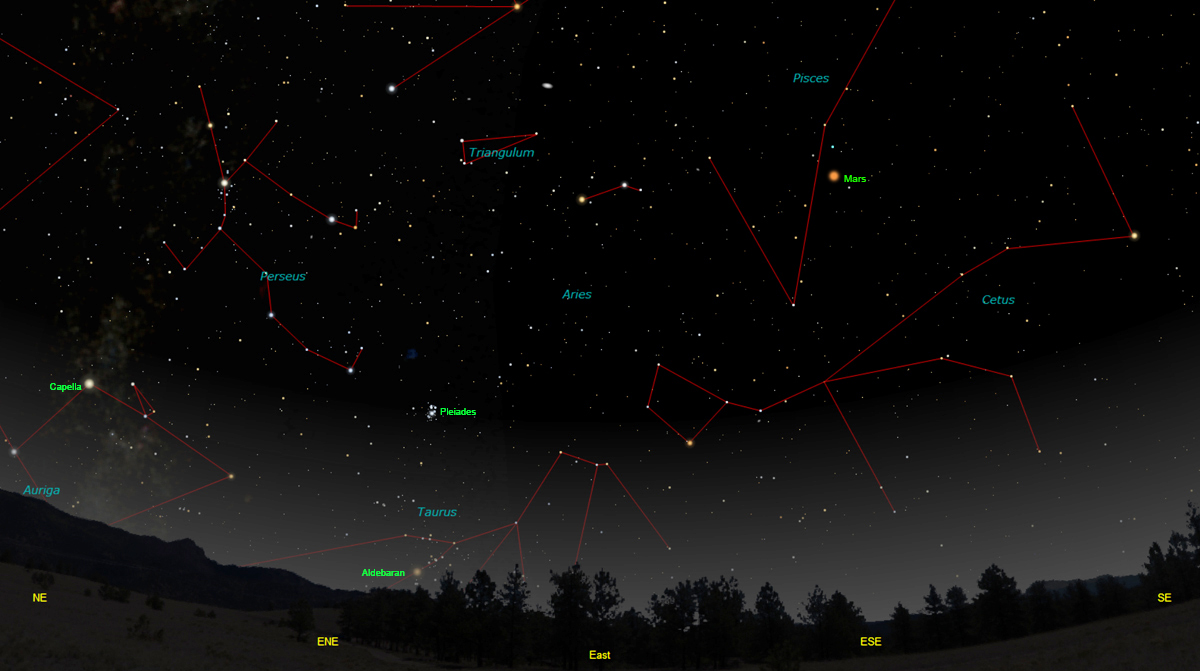The purpose of this feature is to give scout leaders, educators and naturalists an idea of some of the natural events coming up each month. We will try to cover a variety of natural events ranging from sky events to calling periods of amphibians, bird and mammal watching tips, prominent wildflowers and anything else that comes to mind. We will also note prominent constellations appearing over the eastern horizon at mid-evening each month for our area for those who would like to learn the constellations. If you have suggestions for other types of natural information you would like to see added to this calendar, let us know! Note: You can click on the hyperlinks to learn more about some of the featured items. To return to the Calendar, hit the "back" button on your browser, NOT the "back" button on the web page. All charts are available in a "printer friendly" mode, with black stars on a white background. Left clicking on each chart will take you to a printable black and white image. Though we link book references to nationwide sources, we encourage you to support your local book store whenever possible.
Notes From September 2020
Mars is always fascinating to view, but it takes patience to wait for the moments when the Earth's atmosphere steadies. The darker areas may change shape slowly over time, and the fainter detail can be maddeningly difficult to make out. Most first-time observers can make out the bright white polar cap, and perhaps just a few dark smudges across the face of the planet. People's expectations for Mars often exceed what they actually see in the eyepiece. The Mars of everyone's imagination, combined with the brightness of the naked eye view, makes expectation exceed reality. Mars is a fairly small planet, only a little over half the diameter of the Earth (4,212 miles versus 7,917 miles), and even at a close opposition it is over 30 million miles away. It's easier to see the surface features of Mars using imaging techniques that choose the sharpest images in a video and then average them. This is how the image at right was created. Compare that image with the National Geographic map below.
The difficulty of observing details on the Martian surface have led some observers to believe they were seeing details that weren't really there. The first of the illusory Martian "canals" appeared on maps created by the Italian astronomer Geovanni Schiaparelli in 1877. Schiaparelli called these features channels (Italian "canali") and believed they were natural features. Others, particularly Percival Lowell, saw the linear features as an indication of intelligent life on Mars. A whole world view developed in which Mars was a dying planet, where heroic Martian engineers struggled to convey water from the poles down to the deserts that covered most of the planet. In subsequent maps the canals became much more numerous, much straighter. Some were drawn as double canals, and many oases were drawn where the canals met.
Of course, not every astronomer viewing the planet saw the canals. Nathanial Green did not show them in his excellent map of 1877. Tellingly, the eagle-eyed Edward Emerson Barnard, one of greatest observers of all time, did not see them. He wrote, "I have been watching and drawing the surface of Mars. It is wonderfully full of detail. There is certainly no question about there being mountains and large, greatly elevated plateaus. To save my soul, I can't believe in the canals as Schiaparelli draws them. I see details where he has drawn none....I verily believe, for all the verifications...that the canals as depicted by Schiaparelli are a fallacy and that they will be proved so before many oppositions are past." But the belief in intelligent life on Mars became widespread. Perhaps its peak came around the end of the19th century. In 1891, the Pierre Guzman prize of 100,000 French francs was established, to be awarded to the first person to communicate with a celestial body, and to receive a response. Mars was exempted from the award, as it was thought not to represent enough of a challenge!
Mariner 9 was the first spacecraft to orbit another planet, and it was the first to show the surface of Mars well. Before the spacecraft reached Mars, Carl Sagan was in a panel discussion and talked about the Martian canals. Sagan, a skeptic, made a comment that summed up the whole canal controversy; "There is no question that the straightness of the lines is due to intelligence. The only question concerns which side of the telescope the intelligence is on." But the planet still seems to have a pull on me. Schiaparelli's nomenclature for the surface features, though altered somewhat on modern maps, is beautiful and still used today. A scholar, his names were mostly from Homer, Herodotus, and the Bible. Greek myths abound. I once saw a small dark area on Mars called Nodus Alcyonius. I found that the name referred to the legend of Alcyone and Ceyx in Ovid. That led me to kingfishers, and back to our Belted Kingfisher, Ceryle Alcyon. Since, I've never looked at a kingfisher dropping off a branch and flying along the water's surface, calling, in quite the same way. Schiaparelli did make some amazing observations. He named one frequently occuring white spot on Mars, "Nix Olympica" (Latin, Snows of Olympus). He noted that even when most of the other features on the planet were hidden by dust storms, Nix Olympica could still be seen. As it turns out, he was viewing the wave clouds that form over the feature now known as Olympus Mons, the highest mountain in the solar system. NASA's Mars 2020 mission is scheduled to land on Mars on February 18, 2021. The Perseverance rover will search for signs of ancient life and collect samples to send back to Earth. SpaceX is scheduled to send a manned mission to Mars as early as 2024. The topic of "terraforming" Mars has been discussed for quite a while. Such changes may have to be made as we expand our frontiers, but history tells us that there are winners and losers in every expansion. I hope we take care and choose wisely.
Sky Events for October 2020:
Morning Sky: Venus continues to dazzle in the dawn sky this month, now rising about 3 hours before the Sun. As the month progresses its apparent size diminishes and it gets more gibbous. It is the brightest star-like object in the eastern sky before dawn so you won't have any problem picking it out.
Evening Sky:
Saturn is only about 7 degrees to the east of Jupiter as the month begins. Like Jupiter it will remain in Sagittarius this month. Saturn is due south about 8:45pm EDT as the month begins. If you've never seen Saturn, it's simply spectacular in just about any size telescope.
In fact, even a good quality 60mm refractor will give a better view of the ringed planet than Galileo was ever able to see. Saturn was a puzzle to him. In his low-resolution telescope the planet appeared as three separate discs - one large disc with a smaller disc on each side of it. A few years later, he returned to look at the planet when the rings presented edge-on. His two attendant discs had disappeared! He never solved the riddle. He would have loved to see the view available to just about any amateur astronomer today.
Details can be seen well in larger telescopes in good seeing conditions. If you are not used to viewing Mars it will appear quite small through the eyepiece. After all, its diameter is only a little over half that of Earth. Picking out the subtle details on Mars takes patience. Plan on spending some time viewing it and wait for moments when the atmosphere steadies.
The views below show the sky looking east at 10:15pm EDT on October 15th. The first view shows the sky with the constellations outlined and labeled. Star and planet names are in green. Constellation names are in blue. The second view shows the same scene without labels. Prominent constellations include Triangulum, the Triangle, Aries, the Ram, and Cetus, the Sea Monster. Auriga, the Charioteer, with its bright star Capella, and Taurus, the Bull, are rising in the northeast. The bright star Aldebaran, a red giant representing the eye of the bull, should just be rising.Above Aldebaran, look for the Pleiades, a beautiful open star cluster. Also called the "Seven Sisters," it has been known since antiquity. In Japan it is known as Subaru, and the Subaru automobile is named for this cluster. Before the Gregorian calendar reform in 1582, the Pleiades culminated around midnight on October 31st, and it has been traditionally associated with Halloween.Clear moonless fall nights are a great time to hunt down deep sky objects in Cygnus. The constellation is just about directly overhead and objects like the Veil Nebula or the Cocoon Nebula are at their best. Don't expect to see the bright colors that long-exposure CCD images capture. Like Halloween ghosts, these objects hover at the limit of visibility in small telescopes.
On Learning the Constellations: We advise learning a few constellations each month, and then following them through the seasons. Once you associate a particular constellation coming over the eastern horizon at a certain time of year, you may start thinking about it like an old friend, looking forward to its arrival each season. The stars in the evening scene above, for instance, will always be in the same place relative to the horizon at the same time and date each October. Of course, the planets do move slowly through the constellations, but with practice you will learn to identify them from their appearance. In particular, learn the brightest stars for they will guide you to the fainter stars. Once you can locate the more prominent constellations, you can "branch out" to other constellations around them. It may take you a little while to get a sense of scale, to translate what you see on the computer screen or what you see on the page of a book to what you see in the sky. Look for patterns, like the stars that make up the constellation of Perseus. The earth's rotation causes the constellations to appear to move across the sky just as the Sun and the Moon appear to do. If you go outside earlier than the time shown on the charts, the constellations will be lower to the eastern horizon. If you observe later, they will have climbed higher. To observe faint objects, it's always better to wait until they are high in the sky. As each season progresses, the earth's motion around the sun causes the constellations to appear a little farther towards the west each night for any given time of night. The westward motion of the constellations is equivalent to two hours per month. Recommended: Sky & Telescope's Pocket Star Atlas is beautiful, compact star atlas. A good book to learn the constellations is Patterns in the Sky, by Hewitt-White. For sky watching tips, an inexpensive good guide is Secrets of Stargazing, by Becky Ramotowski.
A good general reference book on astronomy is the Peterson
Field Guide,
A Field Guide to the Stars and Planets, by Pasachoff. The book retails for around $14.00.
The Virtual Moon Atlas is a terrific way to learn the surface features of the Moon. And it's free software. You can download the Virtual Moon Atlas here. Apps: We really love the Sky Safari 6 Pro. It is available for both iOS and Android operating systems. There are three versions. The Pro is simply the best astronomy app we've ever seen. The description of the Pro version reads, "includes over 100 million stars, 3 million galaxies down to 18th magnitude, and 750,000 solar system objects; including every comet and asteroid ever discovered." A nother great app is the Photographer's Ephemeris. Great for finding sunrise, moonrise, sunset and moonset times and the precise place on the horizon that the event will occur. Invaluable not only for planning photographs, but also nice to plan an outing to watch the full moon rise. Available for both androids and iOS operating systems.
Amphibians:
Recommended: The Frogs and Toads of North America, Lang Elliott, Houghton Mifflin Co. Archives (Remember to use the back button on your browser, NOT the back button on the web page!) Natural Calendar September 2020 Natural Calendar February 2020 Natural Calendar December 2019 Natural Calendar November 2019 Natural Calendar September 2019 Natural Calendar February 2019 Natural Calendar December 2018 Natural Calendar November 2018 Natural Calendar February 2018 Natural Calendar December 2017 Natural Calendar November 2017 Natural Calendar October 2017Natural Calendar September 2017 Natural Calendar February 2017 Natural Calendar December 2016 Natural Calendar November 2016 Natural Calendar September 2016Natural Calendar February 2016 Natural Calendar December 2015 Natural Calendar November 2015 Natural Calendar September 2015 Natural Calendar November 2014 Natural Calendar September 2014 Natural Calendar September 2013 Natural Calendar December 2012 Natural Calendar November 2012 Natural Calendar September 2012 Natural Calendar February 2012 Natural Calendar December 2011 Natural Calendar November 2011 Natural Calendar September 2011 Natural Calendar December 2010 Natural Calendar November 2010 Natural Calendar September 2010 Natural Calendar February 2010 Natural Calendar December 2009 Natural Calendar November 2009 Natural Calendar September 2009 Natural Calendar February 2009 Natural Calendar December 2008 Natural Calendar November 2008 Natural Calendar September 2008 Natural Calendar February 2008 Natural Calendar December 2007 Natural Calendar November 2007 Natural Calendar September 2007 Natural Calendar February 2007 Natural Calendar December 2006 Natural Calendar November 2006 Natural Calendar September 2006 Natural Calendar February 2006
Natural Calendar December 2005
Natural Calendar November 2005
Natural Calendar September 2005
Natural Calendar February 2005
Natural Calendar December 2004
Natural Calendar November 2004
Natural Calendar September 2004
Natural Calendar February 2004
Natural Calendar December 2003
Natural Calendar November 2003 Natural Calendar February 2003 Natural Calendar December 2002 Natural Calendar November 2002 Nature Notes Archives: Nature Notes was a page we published in 2001 and 2002 containing our observations about everything from the northern lights display of November 2001 to frog and salamander egg masses. Night scenes prepared with The Sky Professional from Software Bisque All images and recordings © 2020 Leaps
|
|

